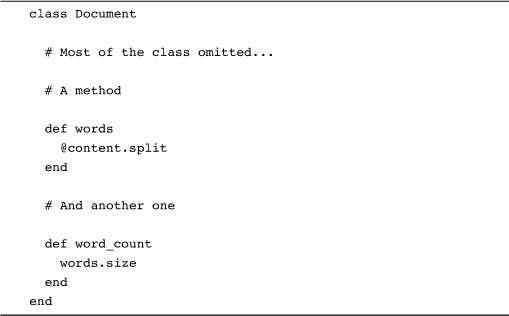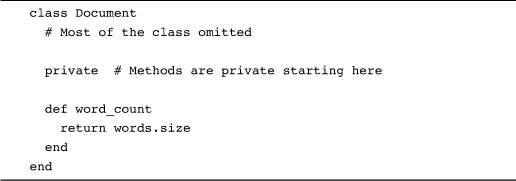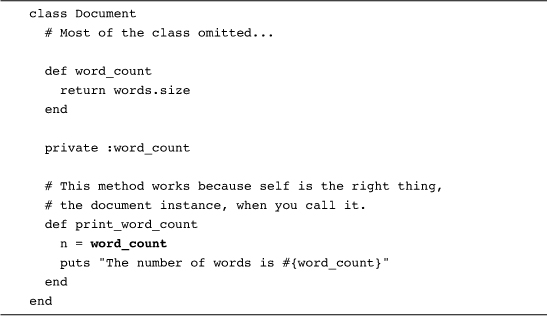Chapter 7. Treat Everything Like an Object—Because Everything Is
Early in my career I worked with a mainframe operating system that had a variety of file types. That old OS supported text files for your documentation, source files for your code, executable files for your programs, and data files for your output. Actually, “supported” is not really the right word. “Imposed with an iron fist” would be more accurate. Creating new files involved specifying the file type using a complex and arcane syntax. You needed to use one command for copying data files and a similar, but subtlety different, command for copying source files. Converting from one file type to another was a task worthy of a Ph.D. I’m sure that the designers of that ancient system had originally set out to make life easier for their users by imposing some order on the everyday complexities of computing. Along the way, however, they lost sight of something important: Sometimes—like when you are trying to make a copy—a file is just a file.
Ruby is an object oriented programming language, which means that the world of Ruby is a world of objects, instances of Date and String and Document and a thousand other classes. As different as all these objects are bound to be, at some level they are all just objects. In the pages that follow we will focus on the things that all Ruby objects have in common. We will start by doing a quick tour of the Ruby object system and then look at how pervasive objects are in Ruby. Next we will look at the methods common to all Ruby objects, the basic toolkit that every object inherits, and at how you can control access to methods. We will round out the chapter by looking at how classes and methods play a key role in the infrastructure of Ruby itself and at some avoidable potholes lurking in the land of the object.
A Quick Review of Classes, Instances, and Methods
On the surface, Ruby is a very conventional, almost boring, object oriented language. Every Ruby object is an instance of some class. Classes mainly earn their keep by providing two key things: First, classes act as containers for methods:

Second, classes are also factories, factories for making instances:
doc = Document.new( 'Ethics', 'Spinoza', 'By that which is...' )
Once you have an instance, you can call methods on it using the more or less universal object oriented syntax of instance.method_name:
doc.word_count
During a method call, Ruby sets self to the instance that you called the method on, so that if you added this to Document:
And then ran doc.about_me, you would see something like:

Ruby treats self as a sort of default object: When you call a method without an explicit object reference, Ruby assumes that you meant to call the method on self, so that a call to plain old word_count gets translated to self.word_count. You should rely on this assumption in your code: Don’t write self.word_count when a plain word_count will do.1
Every class—except one—has a superclass, someplace that the class can turn to when someone calls a method that the class doesn’t recognize. If you don’t specify a superclass when you are defining a new class, the new class automatically becomes a direct subclass of Object. Our Document class, for example, is a direct subclass of Object. Alternatively, you can specify a different superclass:

The Ruby technique for resolving methods is straight out of the object oriented handbook: Look for the method in the class of the object. If it is there, call it and you are done. If not, move on to the superclass and try there. Repeat until you either find the method or run out of superclasses.2
Objects All the Way Down
While Ruby’s basic object system is not the most original bit of technology, it does have something very powerful going for it: consistency. You can see just how consistent Ruby’s object oriented philosophy is by computing the absolute value of a number:
-3.abs # Returns 3
Nothing very exciting there ... except for the syntax. Why is it -3.abs and not abs(-3)? The answer is both simple and profound: In Ruby the number -3 is an object. When you say -3.abs, you are calling the abs method on an object, an object that goes by the name -3. It’s not just the numbers either. In Ruby, strings and symbols and regular expressions are all objects, objects that come equipped with their very own methods:

In fact, virtually everything you come across in Ruby is an object. You might, for example, think that true and false are a couple of special Ruby language constructs. Not so—they’re just objects:

true.class.class # Returns Class
Even our old buddy—and sometimes nemesis—nil is an object:
![]()
In Ruby, if you can reference it with a variable, it’s an object.
The Importance of Being an Object
Actually, if you can reference it with a variable it’s probably not just an object, but an Object, an instance of the Object class.3 Since virtually all Ruby objects can trace their ancestry back to Object, virtually all Ruby objects have a set of methods in common: the ones they inherit from Object. So the next time you call class or instance_of? to see just what sort of object you have, thank the Object class for supplying those methods. The Object class is also the source of the well-worn to_s method, which returns a string representation of your object. It’s the to_s method that puts relies on to turn its arguments into printable strings.4 Like a lot of Object methods, you can rely on the default implementation of to_s. So if you ran this:
![]()
You would see something like:
#<Document:0x8767120>
Alternatively, you can override to_s for your own purposes:

With the class above, our documents would print out something like:
Document: Emma by Austin
Instances of Object also inherit some more esoteric talents. For example, the eval method, defined by Object, takes a string and executes the string as if it were Ruby code. The possibilities with eval are literally limitless: Having eval around means that every Ruby programmer has the entire Ruby language available at a moment’s notice. You can, to take an easy example, create a quick riff on irb with nothing more than eval and a handful of other Object supplied methods:5

Run the code above and you will find yourself in a very irb-like loop:

The Object class also supplies a set of reflection-oriented methods, methods that let you dig into the internals of an object. We met one of these in the last chapter: the public_methods method, which returns an array of all the method names available on the object. There is also instance_variables, which will pull out the names of any instance variables buried in the object. So, if you run this:
pp doc.instance_variables
You will see:
[:@title, :@author, :@content]
In all, Object bestows about fifty methods on its children.
Public, Private, and Protected
Like a lot of object oriented programming languages, Ruby lets you control the visibility of your methods. Methods can either be public—callable by any code anywhere, or private, or protected. Ruby methods are public by default, so up to now all of our Document methods have been public.
You can make your methods private by adding private before the method definition:

Or by making them private after the fact:

Ruby’s treatment of private methods is a bit idiosyncratic. The rule is that you cannot call a private method with an explicit object reference. So if word_count was indeed private, then this:
n = doc.word_count
Will throw an exception, since we tried to use an explicit object reference (doc) in the call. By restricting the way that private methods can be called, Ruby ensures that private methods can only be called from inside the class that defined them. Thus the call to word_count in the print_word_count method that follows will work:

Note that in Ruby, private methods are callable from subclasses. Think about it: You don’t need an explicit object reference to call a superclass method from a subclass. Thus, this is a perfectly functional bit of code:
The rules for protected methods are looser and a bit more complex: Any instance of a class can call a protected method on any other instance of the class. Thus, if we made word_count protected, any instance of Document could call word_count on any other instance of Document, including instances of subclasses like RomanceNovel.
There are a couple of things to keep in mind about private and protected methods in Ruby. The first is that while Ruby’s system of controlling method visibility is perfectly respectable, it doesn’t get a lot of use. For example, if you look at the Ruby standard library you will find nearly 200,000 lines of code. In that huge pile of software, private appears just over 1000 times and protected only about fifty times. Second, remember that just because the rules say that you can’t call some private or protected method, well, you can still call it. Among the methods that every object inherits from Object is send. If you supply send with the name of a method and any arguments the method might need, send will call the method, visibility be damned:
n = doc.send( :word_count )
The Ruby philosophy is that the programmer is in charge. If you want to declare some method private, fine. Later, if someone, perhaps you, wants to violate that privacy, fine again. You are in charge and presumably you know what you are doing.
In the Wild
One thing that takes a while to sink in when learning Ruby is just how central the idea of methods and method calls are to the fundamental infrastructure of the language. Certainly there are lots of of things that go on in Ruby that are not method calls. Assigning a value to a local variable is not a method call. An if statement is not a method call. Neither is a while loop. Once, however, you get beyond the lowest layer of basic infrastructure, a surprising number of things you might consider to be part of the language are, in fact, just calls to methods. For example, you can’t get much more fundamental than method visibility. Nevertheless, private, the magic word that makes Ruby methods private, is not really magic at all: It’s just a method, albeit one that is implemented inside the Ruby interpreter. The same is true of private’s buddies, public and protected.
The Ruby interpreter also defines another method, one that takes the name of a file, reads the contents of the file, and executes those contents as Ruby code. This method maintains a list of the files it has already processed and won’t re-execute a file that it has already seen. We call that method require:6
require 'date' # A Call to a method
Another set of methods that play the part of language keywords are the attr_accessor family:

Not only are attr_accessor and friends just methods, but they are within the reach of mortal programmers. In Chapter 26 we are going to build our own versions of attr_reader and attr_writer. Stay tuned!
Staying Out of Trouble
The good news is that virtually all Ruby objects7 inherit about fifty methods from the Object class, methods that allow you to do all sorts of useful things. The bad news is that those inherited methods also represent about fifty opportunities to have a name collision. Take this innocent-looking addition to the Document class:

Innocent, except that we have just overridden the Object supplied send method. Know your Object class, if for no other reason than to stay out of its way.
Another way to go wrong is to intentionally override a method from Object—and to get it wrong. Recall that earlier in the chapter we overrode the to_s method so that it would produce a better description of our document. Make a mistake in the to_s method, perhaps like this:

And you will no longer be able to print Document instances via puts.
Finally, programmers new to the language will sometimes forget how uniform the Ruby object model is and invent special cases where none actually exist, perhaps like this:

When they could get away with the much simpler:
puts "The object is an instance of #{the_object.class}"
The single line of code here will work with virtually any object in your Ruby interpreter: Feed it a string and it will tell you that you have a String. Feed it a number and you might see that you have an instance of Fixnum or Float. Feed it nil and it will tell you that you have an instance8 of NilClass. This example illustrates a more general and very pleasant side effect of Ruby’s uniform object system: Since Ruby’s nil is a real object, it is generally much less toxic than the equivalent constructs in other programming languages. When I’m coding in Ruby I don’t have to be quite as paranoid that this object I have might just be nil. Remember, a great way to avoid broken code is to have less of it. The code that you never write will work forever.
Wrapping Up
If you remember anything from this chapter, remember this: Virtually everything in Ruby is an object, and virtually all of those objects inherit a basic set of methods from the Object class. In a very real way, the Object class is the glue that binds Ruby together and lends the language its simple elegance. Given how fundamental the Object class is to Ruby, it shouldn’t come as much of a surprise that we aren’t done with it. In chapters to come, we will look at how you can use the framework provided by the Object class to define your own operators, to create objects with their own ideas of equality, to rewire your inheritance tree, and to handle calls to methods that you haven’t written.
For the moment, however, we will turn our attention to a different question. In this chapter we have focused on the things that all Ruby objects have in common: At their core, the dates and strings and documents floating around in our programs are all the same. But they are also all different: Outside of its Object core, a Date instance is very different from a String instance. The question for the next chapter is simple: How do you keep all of these different objects straight?


